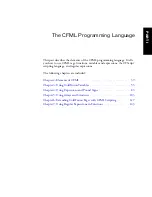
24
Introduction
Using this book
This book can to help anyone with a basic understanding of HTML learn to develop ColdFusion.
However, this book is most useful if you have basic ColdFusion experience, or have read
Getting
Started Building ColdFusion MX Applications
. The Getting Started book provides an introduction
to ColdFusion and helps you develop the basic knowledge that will make using this book easier.
Book structure and contents
The book is divided into seven parts, as follows:
Each chapter includes basic information plus detailed coverage of the topic that should be of use
to experienced ColdFusion developers.
Approaches to using this book
This section describes approaches to using this book for beginning ColdFusion developers,
developers with some experience who want to develop expertise, and advanced developers who
want to learn about the new and enhanced features of ColdFusion MX.
Part
Description
The CFML Programming
Language
The elements of ColdFusion Markup Language (CFML),
including variables, expressions, dynamic code, CFScript, and
regular expressions.
Reusing CFML Code
Techniques for writing code once and using it many times,
including the
cfinclude
tag, user-defined functions, custom
CFML tags, ColdFusion components, and CFXAPI tags.
Developing CFML Applications
How to develop a complete ColdFusion application. Includes
information on error handling, sharing data, locking code,
securing access, internationalization, debugging, and
troubleshooting.
Accessing and Using Data
Methods for accessing and using data sources, including an
introduction to SQL and information on using SQL data bases,
LDAP directory services, and the Verity search engine
Requesting and Presenting
Information
How to dynamically request information from users and display
results on the user’s browser, including graphing data and
providing data to Macromedia Flash clients.
Using Web Elements and
External Objects
How to use XML, Java objects including Enterprise JavaBeans,
JSP pages, web services (including creating web services in
ColdFusion), and COM and CORBA objects.
Using External Resources
Methods for getting and sending e-mail, accessing remote
servers using HTTP and FTP, and accessing files and
directories.
Summary of Contents for ColdFusion MX
Page 1: ...Developing ColdFusion MX Applications...
Page 22: ...22 Contents...
Page 38: ......
Page 52: ...52 Chapter 2 Elements of CFML...
Page 162: ......
Page 218: ...218 Chapter 10 Writing and Calling User Defined Functions...
Page 250: ...250 Chapter 11 Building and Using ColdFusion Components...
Page 264: ...264 Chapter 12 Building Custom CFXAPI Tags...
Page 266: ......
Page 314: ...314 Chapter 14 Handling Errors...
Page 344: ...344 Chapter 15 Using Persistent Data and Locking...
Page 349: ...About user security 349...
Page 357: ...Security scenarios 357...
Page 370: ...370 Chapter 16 Securing Applications...
Page 388: ...388 Chapter 17 Developing Globalized Applications...
Page 408: ...408 Chapter 18 Debugging and Troubleshooting Applications...
Page 410: ......
Page 426: ...426 Chapter 19 Introduction to Databases and SQL...
Page 476: ...476 Chapter 22 Using Query of Queries...
Page 534: ...534 Chapter 24 Building a Search Interface...
Page 556: ...556 Chapter 25 Using Verity Search Expressions...
Page 558: ......
Page 582: ...582 Chapter 26 Retrieving and Formatting Data...
Page 668: ......
Page 734: ...734 Chapter 32 Using Web Services...
Page 760: ...760 Chapter 33 Integrating J2EE and Java Elements in CFML Applications...
Page 786: ...786 Chapter 34 Integrating COM and CORBA Objects in CFML Applications...
Page 788: ......
















































